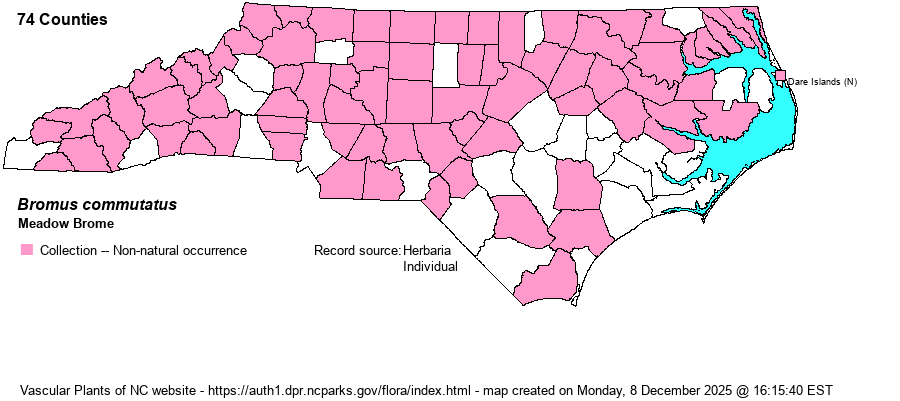| Author | Schrader | |
| Distribution | The differences between this species and B. racemosus are not well defined. Until specimens can be studied and annotated, we will include essentially all NC material in this species, except for the following counties determined by one of the editors (Sorrie) as B. racemosus: Alleghany, Chatham, Dare, Moore, and Person.
Native of Europe; in N.A., present over much of the Southeast. | |
| Abundance | Probably frequent to common nearly throughout, based on Weakley (2018), but confusion with B. racemosus makes abundance determinations somewhat uncertain. | |
| Habitat | Roadsides, fields, fallow fields, disturbed soil. | |
| Phenology | Flowering and fruiting April-July. | |
| Identification | Together, B. racemosus and B. commutatus are most similar to B. japonicus. They differ in their rather stiff, ascending inflorescence branches (vs. lax and arching). | |
| Taxonomic Comments | Bromus is an important genus of grasses for their value as forage (many species) or for the harm they cause to the guts of grazing animals (a few species). In most of our species, inflorescences arch over and cause the spikelets to droop; thus the plants are often graceful looking. Bromus, Festuca, and Poa all can look quite similar to beginners (and even veterans!), because they all have multi-flowered spikelets. Generally speaking, Bromus taxa have much the largest spikelets, and most Poa taxa have a tuft of wispy hairs at the base of each floret (lacking in the other genera). Bromus and Festuca taxa have obvious awns on the florets that are absent in Poa taxa. With field experience and careful use of keys, one can eventually handle these genera. | |
| Other Common Name(s) | | |
| State Rank | SE | |
| Global Rank | GNR | |
| State Status | | |
| US Status | | |
| USACE-agcp | | |
| USACE-emp | | |

